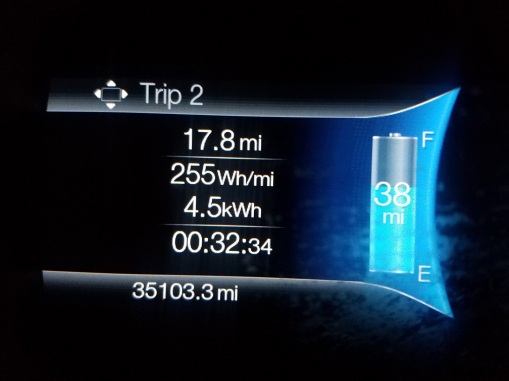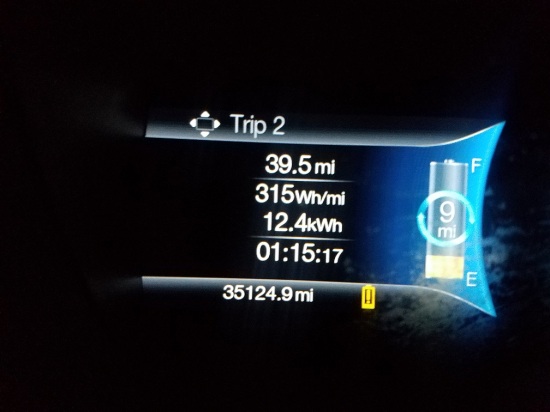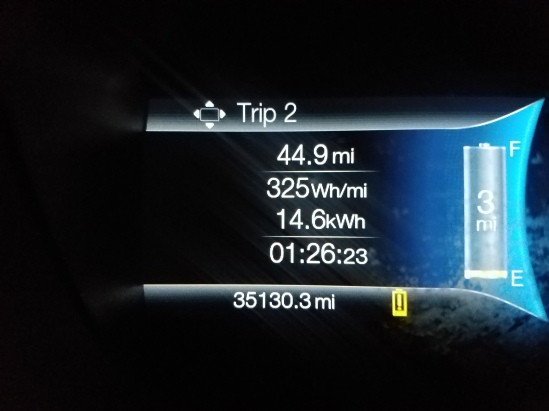One of the biggest questions — if not the biggest question — about electric cars is the battery. Everyone has a phone and knows that after a year or two the battery simply doesn’t last as long as it used to. The problem only gets worse too: the phone will continue to lose capacity over time and this is irreversible as far as we know. This puts a hard limit on how long an electric car will be useful. With a gas car you can keep replacing parts as they break and keep the car for virtually forever. With an electric car there will be a time where the battery becomes nearly useless. How much time is that? No one knows and that’s one of the biggest questions to be answered.
Seeing as my car is five years old and has 35,000 miles on it, how much as my battery degraded? Can I measure it?
Yes, with something called a rundown test. The trip meter in the Ford Focus Electric displays the total kilowatt-hours used (kWh) so by resetting the meter and killing your battery (almost) you should get an idea for how much energy is available to you. Somehow it took me almost a year to do one and I plan on doing one at least every month to get good data on the battery’s condition. It’s not quite that simple though.
The Focus has a 23 kWh battery but that is the total capacity in a new car. Everything seems to point to the fact that the car only lets you use about 80% of the capacity to ward of battery degradation. You see, fully charging and draining lithium-ion batteries wears them out quicker; this is one reason phone batteries die so quickly. By keeping 20% of the battery “off limits” to the driver the battery should last longer. This leaves a new Focus with about 18.5 kWh available.
So where was mine at?
I drove to work and measured the trip with a fully charged battery. My initial idea was to extrapolate downwards so I wouldn’t have to actually deplete the battery. If that worked I could check the capacity any time by doing some math after driving. I needed to compare the real value to my predicted value though to know it was accurate. Here’s a picture of the meter when I got to work.

I used 4.5 kWh at an average of 255 Wh/mi. The car said it could go 38 more miles. Extrapolating by 4.5 kWh +(0.255 kWh/mi *38 mi) = 14.2 kWh. Using this data I should have around 14.2 kWh with the battery discharged.
I then went to my dad’s after work. Here I had 12.4 kWh used at an average of 315 Wh/mi. (I had the heat on now!) I had 9 miles left. Doing what I did before I should have 15.2 kWh after the battery was discharged. As you can see the numbers are close, but not close enough.

Finally I made it home with three miles left on the meter and a total kWh of 14.6 (and after driving for an hour and a half…). If you extrapolate to zero, I should have a total of 15.6 kWh with my average being 325 Wh/mi.

What’s the real value here? I’d probably go with 15.6 kWh. The fact that these values get larger the closer you get to zero is strange; is the car trying to keep you safe by giving you more energy at the lower end of the battery? Or is it just due to rounding error and how averages work early on? I don’t know, but by fully discharging the battery you should have a better picture of its true capacity. The numbers closer to zero should be the most accurate.
So what do I do with this knowledge? Nothing yet; I don’t have enough data to do the next best thing which is graph it and make a trendline, sadly. If the the car really does have 15.6 kWh of capacity, how does that compare with the total of 18.5 kWh? It’s 84% of what it was brand new. That’s pretty crappy to know, but I’m glad I measured it. By eyeballing the meter I thought I had as little as 12 kWh which would be terrible. 84% isn’t bad at all when you consider that I got a used car with 25,000 miles on it and currently had 35,000 miles on it. The car is also five years old. How many cell phones do you think last five years on a single battery? Probably not a lot. The battery is degrading but it doesn’t seem too bad. I’ll keep good numbers on this in the future and hopefully get something more predictive.
(As always if you own an electric car and like to tinker around with stuff and notice a flaw in my methods, please let me know. I’m being as accurate as I can but I could’ve totally overlooked something.)
Wow, that is a lot of degradation for that mileage. I have a 2017 with the larger pack, and with that, I do not ever let it get that low. in 18.000 miles, I have only had it below 10% on 2 occasions. once when I saw how far it would go and brought it down to 2% and another time when it got down to 9%. I have not really done a real test to see where it is at, but I don’t notice that it is less to any degree. I don’t think think the 2017 has the same energy gauge, so i just add up the trip miles and KW used between charges. I also have noticed that the range is a little less when the temperature outside is consistently in the 40’s as compared to summer in the 70’s (I live on the coast by San Francisco). I still calculate that at my current average of 237 W/Mile, that I can go 125 miles per charge and have a usable capacity of just under 30 KW. A few weeks ago after I charged it up, it gave an estimate of 129 miles and i have found that would be doable. I also gauge that when I get home from work, I always have about 99 miles left after leaving work with a full charge. This is the same as when it was new. I would guess that yours has degraded that bad by using the full capacity of the battery on a very consistent basis, where I only use about 30-50% a day. I also leave work on Friday with a full charge, do not charge it over the weekend and return to work on Monday with about 15-20% left. I usually drive about 100 miles in that time, so that tells me it still has the advertised range with 18,000 miles on it.
LikeLike
There are probably a few things going on here. Your battery is pretty new and you’ve been tossing miles on it quickly compared to mine, especially with its past owner. We got our car around four years old and at 25,000 miles; this is an average of around 6,000 per year. Like you said, I probably use more of the battery’s full charge more frequently as it holds less charge. Time degradation and heavy use seems to be less of a factor for you and probably saves the battery. I also live in Illinois and the winter doesn’t help since we have no choice but to run the heater, further murdering the battery. I’m also hoping that Ford has made progress in their battery chemistries and thermal management systems and has made a better product.
It is nice to hear how other people’s batteries are holding up!
LikeLike